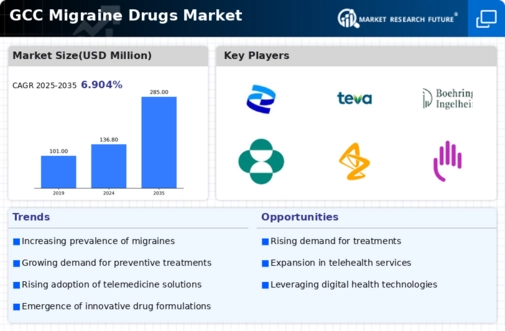The GCC Migraine Drugs Market is characterized by a dynamic competitive landscape, influenced by the rising prevalence of migraine disorders across the region and increasing awareness among consumers about treatment options. This market is defined by a variety of pharmaceutical companies that offer an array of medications, including abortive and preventive treatments that cater to diverse patient needs. The competitive insights within this market reveal a focus on innovative drug development, strategic partnerships, and robust distribution networks that enable these companies to tap into the growing patient population.
Companies operating in this sector are continuously investing in research and development to create novel therapies that promise better efficacy and safety, which are essential factors in the treatment of migraines. Furthermore, the expansion of healthcare facilities and increased access to prescription medications in the GCC region encourage the proliferation of migraine treatment options among patients.Pfizer has established a notable presence in the GCC Migraine Drugs Market, bolstered by its innovative portfolio of migraine therapies and strong brand recognition.
The company's strengths lie in its extensive research capabilities and its commitment to addressing the specific needs of migraine patients through targeted drug formulations.
Pfizer's established distribution network across the GCC region ensures that its migraine medications are readily available to healthcare providers and patients alike. The company's strategic collaborations with healthcare providers and stakeholders enhance its market positioning, enabling it to respond effectively to emerging trends in migraine treatment. Moreover, Pfizer's focus on patient education and support further strengthens its competitive edge in promoting the usage of its migraine-related treatments.Teva Pharmaceutical Industries is another significant player in the GCC Migraine Drugs Market, known for its comprehensive range of products targeting migraine relief.
The company emphasizes its commitment to developing effective and affordable therapies, catering to a wide demographic of patients experiencing migraine symptoms. Teva's key product offerings include both generic and branded medications, with an eye toward expanding its therapeutic portfolio in the GCC region. The company's strong market presence is further supported by strategic mergers and acquisitions, which enable it to enhance its resources and capabilities in delivering innovative migraine treatments.
Teva's strengths also lie in its robust manufacturing infrastructure and distribution strategies, which facilitate the timely availability of its products across the GCC. The company's approach of integrating feedback from healthcare providers and patients into its product development process enhances its ability to meet the diverse needs of the migraine patient population effectively.






















